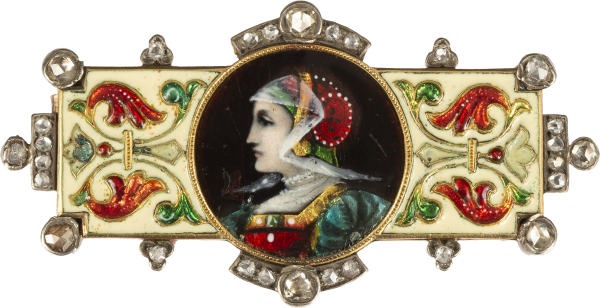


Cape Clasp
, France (Paris), c. 1890

Cape Clasp
Description
Two identical openwork roundels in relief show a Chinese dragon head in cast and chased silver, entwined by a serpentine body with bird’s feet and talons. The eyes are formed of opal cabochons. Both roundels are joined by a wire loop and hook as clasp and eight chain links of twisted wire with intersecting plain loops. Traces of gilt remain. On the reverse along the edge of both roundels is the maker’s mark “WIESE” for Louis Wièse.
This beguiling cloak clasp stands out as highly unusual in Louis Wièse’s jewelry. The face of a dragon, its opal eyes glimmering, emerges out of the center of each medallion. A pug nose sits atop of mustache-shaped mouth, below which appear tiny fangs. Although the intricate body and tail of the dragon wraps around the face on each example, they are not identical; the dragon’s tail sits atop the face on the left clasp and below it on the right one. Ferocious these dragons are not; if anything, they arouse amusement.
Wièse’s attraction to Gothic art must have inspired the form of the clasp, which harkens back to medieval fashions. However, the dragons reflect the fascination with “orientalism” so prevalent in the arts of Europe after Japan opened its doors to international trade in 1854. Japanese woodcuts and applied arts were shown at the International Exhibition in London in 1862 and then in the 1870s in Paris, Vienna, and Philadelphia. Known as “Japonisme,” the movement took its inspiration from both China and Japan. Samuel Bing (1838–1905), an art dealer from Hamburg, who opened a shop in Paris and founded in 1888 the journal Le Japon Artistique was a key figure in introducing objets d’arts from Japan, China, and other Asian countries to a broader public.
The Chinese dragon, in comparison to the European, has the body of a snake, talons of an eagle, antlers of a deer, and eyes of a demon, like here. In Chinese folklore, the dragon symbolizes wisdom, power, and luck and is believed to protect against all evil. Japan took the dragon motif from China where it symbolizes a successful life.
Literature:
compare Mauriès and Possémé 2017, pp. 118–119 (an identical cloak clasp by Louis Wièse in the Musée des Arts Décoratifs, Paris); exh. cat. French Jewellery of the Nineteenth Century, 2001, no. 79 (for the same motif on a gold brooch); Weisberg 1986 (on Asian dragons); and Wichmann 1981, pp. 336–339 (on Bing).
